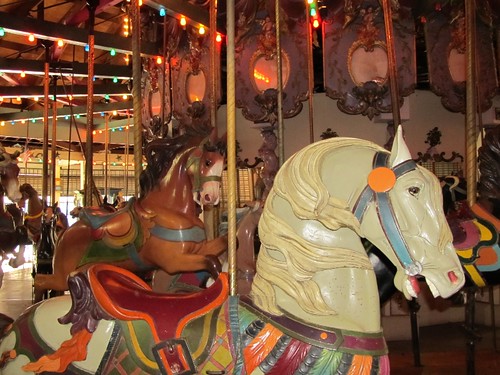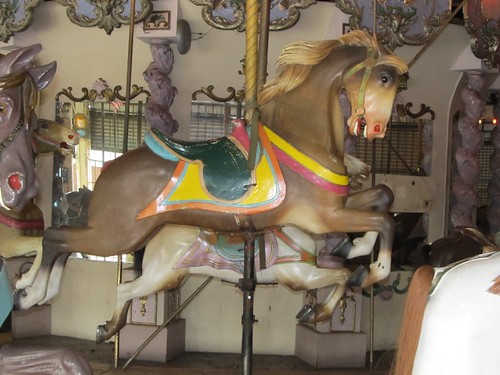To call the Forest Park Carousel a rare work of art is understatement. In an age when we’re so often attached to complex 21st century electronic devices, a simple ride on a carousel still enchants its young and young-at-heart riders, just as it did those who rode carousels a century ago. In the Golden Age of carousels, between 1880 and around 1930, artists and park owners created some 4,000 carousels in the United States, according to the International Museum of Carousel Art. Of those thousands, only 150 are intact today. The Forest Park Carousel is one of those survivors.
It’s not only a rarity numbers-wise, but in beauty, exquisiteness, and handmade artistry. The carousel in Woodhaven, Queens is one of just two remaining carousels that Daniel C. Muller carved by hand out of wood in elaborate, expressive detail just over 100 years ago. Among a group of master carvers during the Golden Age, Muller stood out for his ability to create horses and other animals that have lifelike features, power, and intricacy. Muller and his brother, Alfred, created some 12 carousels through their small company, D.C. Muller and Brother Co. This carousel in Queens and one in Cedar Point, Ohio, are the only two surviving, according to the National Carousel Association.
Given the Forest Park Carousel’s distinction, the New York City Landmarks Preservation Commission (LPC) on Tuesday, June 25, designated it as a landmark. Capping an effort by fans, local groups, and Queens and neighborhood civic leaders, the landmark designation ensures the carousel’s preservation as a Woodhaven attraction for future generations. It is located just north of West Main Drive in this 538-acre park. The New York City Department of Parks and Recreation owns the carousel.
This designation comes after an up-and-down ride during the past three decades when concessionaires restored the carousel and saw it thrive at times, or closed and abandoned it at others. An operator had shut down the beloved carousel as recently as 2009. However, a new concessionaire, NY Carousel, reopened it on Memorial Day weekend of 2012. Moreover, the operator is committed to a decade-long refurbishment of this jewel. Now, any alteration, reconstruction, or similar change would have to obtain the LPC’s approval.
“We’re Thrilled”
The carousel’s advocates are elated. “This is tremendous news. The Forest Park Carousel means so much to countless residents in Woodhaven and across the city. This designation is long overdue, but now that it’s here, we’re thrilled,” says Edward Wendell, president of the Woodhaven Residents’ Block Association and the Woodhaven Cultural & Historical Society. “With the carousel landmarked, we know it will be around for posterity, which is exactly how it should be.”
Enormous effort and attention to style went into this Muller carousel, in an era when companies and carvers produced gorgeous, elaborately carved carousels that were a main feature of amusement parks in towns and cities. William Dentzel, son of Gustav Dentzel, one of the men who pioneered the building of carousels in America, carved the frame for this carousel in 1890. In 1903, Muller – who worked for William Dentzel for a time before and after he and his brother had the family company – carved the horses and other animals. The Forest Park carousel has 36 jumping horses and 13 standing horses, plus one each of a lion, deer, and tiger, and two chariots. The figures are arranged in three concentric circles. It also contains an ornate organ that the German company A. Ruth & Sohn Band Organ Co. made.
When you think of a child bounding up onto the platform to choose a certain horse, consider how Muller’s talent still brings delight to those who ride. Trained at the Pennsylvania Academy of Fine Arts, Muller was well-known for his meticulous attention to details and features. He was one of the men, mainly German immigrants, who carved horses in the Philadelphia style, named for the city where the companies were.
The hand-carved horses of the Forest Park Carousel (Photo credit: Joey Wendell – Project Woodhaven)
How many have ridden this spirited horse over the century of its existence? (Photo credit: Joey Wendell – Project Woodhaven)
What makes the Philadelphia-style horses different from the Coney Island and County Fair styles? Muller’s carved horses are more natural and realistic-looking than carousel horses in other styles, and they’re large and strong in appearance (the Coney Island-style horses tend to be more slender and not as natural-looking). Muller’s horses are very individualistic and sport detailed military accoutrements or saddles, plus flowers, garlands, ribbons, and tassels, in a wide array of colors. Most especially, his horses have expressive features, even sensitive eyes, according to the site of PJ’s Carousel Collection, which makes miniature limited-edition carousel horses.
A Search for the Right Steeds
For many decades, this carousel was in operation in Dracut, Mass., until 1971. But it was then closed and dismantled. A turn of events brought it to Woodhaven shortly afterward. The carousel in Forest Park had burnt down in December, 1966. Concessionaire Restaurant Associates found this carousel, which a Connecticut architect, Victor Christ-Janer, had acquired. The concessionaire’s director of park planning, Arthur Schleifer, who had discovered the existence of this carousel after a two-year search, knew it was a treasure and negotiated an agreement with Christ-Janer to acquire the carousel. The company restored it at a cost of $275,000 and reopened a carousel in Forest Park in November, 1973.
“We decided to restore it because it is a work of art. It can’t be duplicated today,” Schleifer told The New York Times then. “It’s all hand-made and it would cost much more than $275,000 to duplicate it.” In 1973, the cost of a five-minute ride was 25 cents. Today, a ride costs $3, still a very good price for such fun and pleasure.
Woodhaven community leader Wendell summed up his feelings about the carousel’s landmark designation in a word: relieved. He and his wife, Joey, first became involved in the carousel’s saving several years ago after it was shuttered and they heard rumors that the historic carousel was about to be dismantled and sold off, he says. The residents collected petitions, started a Facebook page, sold “Save the Carousel” T-shirts, and “did anything we could to keep the story of our carousel on everyone’s radar,” Wendell recalls.
“What this does now is ensure that this carousel will be up and running for many more generations, and we don’t need to worry about it being packed up and carted off in the middle of the night, like Civic Virtue,” Wendell says, referring to the city’s movement of the Triumph of Civic Virtue statue from Queens Boulevard to Green-Wood Cemetery in Brooklyn, an action that has upset some Queens residents.
It’s almost unbelievable that this century-old carousel from the Golden Age has survived and is still operating, when so many thousands of these attractions are gone. How did this happen? People who knew what a priceless treasure this was intervened, worked hard, and invested in it, so that today the Forest Park Carousel is not just some image in a long-ago photograph. Now, the children of Queens and elsewhere, and their children’s children, will get to take the same sweet ride that has delighted so many through the decades.
Further Exploration To check out more about the Forest Park Carousel, the long initiative to have the LPC designate it as a landmark, and working carousels in general, also see: Project Woodhaven Visits the Forest Park Carousel (2011) Forest Hills Times: A Step Closer to Landmark Status The National Carousel Association Photo Show: The Forest Park Carousel (2003)
The National Carousel Association North American Photo Shows
The National Carousel Association Census of Operating North American Carousels





Great story, Susan. So nice to see a work of art like this preserved but more importantly just being used and enjoyed as it was intended.
Thanks so much, David. Appreciate it. I so agree with you: The preservation is one important aspect. But the thrilling part is that this carousel will be there for people to ride on, just as their ancestors have done. Good that the concessionaire sees the importance of the preservation, too!
Cheers,
Susan
Lovely article which brought to mind “my” childhood carousel at Hempstead Lake State Park. Thank goodness some of these beauties are being preserved and enjoyed!
Thanks, Gretchen! How lucky that you had a favorite. I can barely remember the ones I rode in Western PA. I wonder what happened to the one you enjoyed so much.
Gratefully,
Susan
http://nationalcarousel.org/psp/WestHempstead/
It’s still there, Susan! Here’s the photo link I mentioned to you.
Gretchen,
Wow, how wonderful! I consider it almost miraculous when any of these historic carousels are still there. From the photos, I can see it’s fantastic, a real beauty! Very alive and enchanting. It must be great to see this carousel, about which you have fond memories.
As the National Carousel Association (NCA) census page details, this 1914-built carousel has been at Hempstead Lake State Park since 1931. I saw from the NCA’s photo show page on it (the link you provided above) that it is an “Illions carousel.” Given your own incredible curiosity, you may have followed up on this (and certainly other carousel fans would be interested): This is an M.C. Illions carousel, from another one of the most famous carvers.
So the fellow behind it was Marcus Charles Illions. His horses were known for flamboyant heads and well-decorated bodies, the NCA notes. Illions was an immigrant to the U.S. — I’ve seen his home country listed, depending on the source, as Russia or Lithuania, so I am not sure which is correct. His carving skills and artistry were legendary.
The International Museum of Carousel Art explains that he first worked with Charles Looff and then began a collaboration with carousel builder W. F. Mangels in which they created magnificent, imaginative carousels. In 1909, Illions started his own company, M.C. Illions and Sons Carousell Works, which was in Coney Island.
Illions is one of the key carvers who developed the “Coney Island style” of carousels, with “latticework harnesses and other virtuoso feats of carving,” according to the Coney Island History Project (quoting historian and collector Rol Summit). His horses had strong qualities of movement with flowing manes and straining bodies, etc.
Well, you can see that a mention and link of one of these historic carousels, such as the one at Hempstead Lake State Park, can just start me off on quite a little research jaunt!
The Great Depression ended the great demand for the work of these carousel carvers. Thankfully, a number of these carousels are still with us, to appreciate and enjoy.
Grateful for the link and your recalling of your own special carousel,
Susan
I grew up in Glendale, Queens, riding this beautiful carousel. So many happy memories. So glad to see that it is now a landmark.
Janet,
I agree: How wonderful that a place so special to you will be there for children in coming years to have their own memories.
Susan